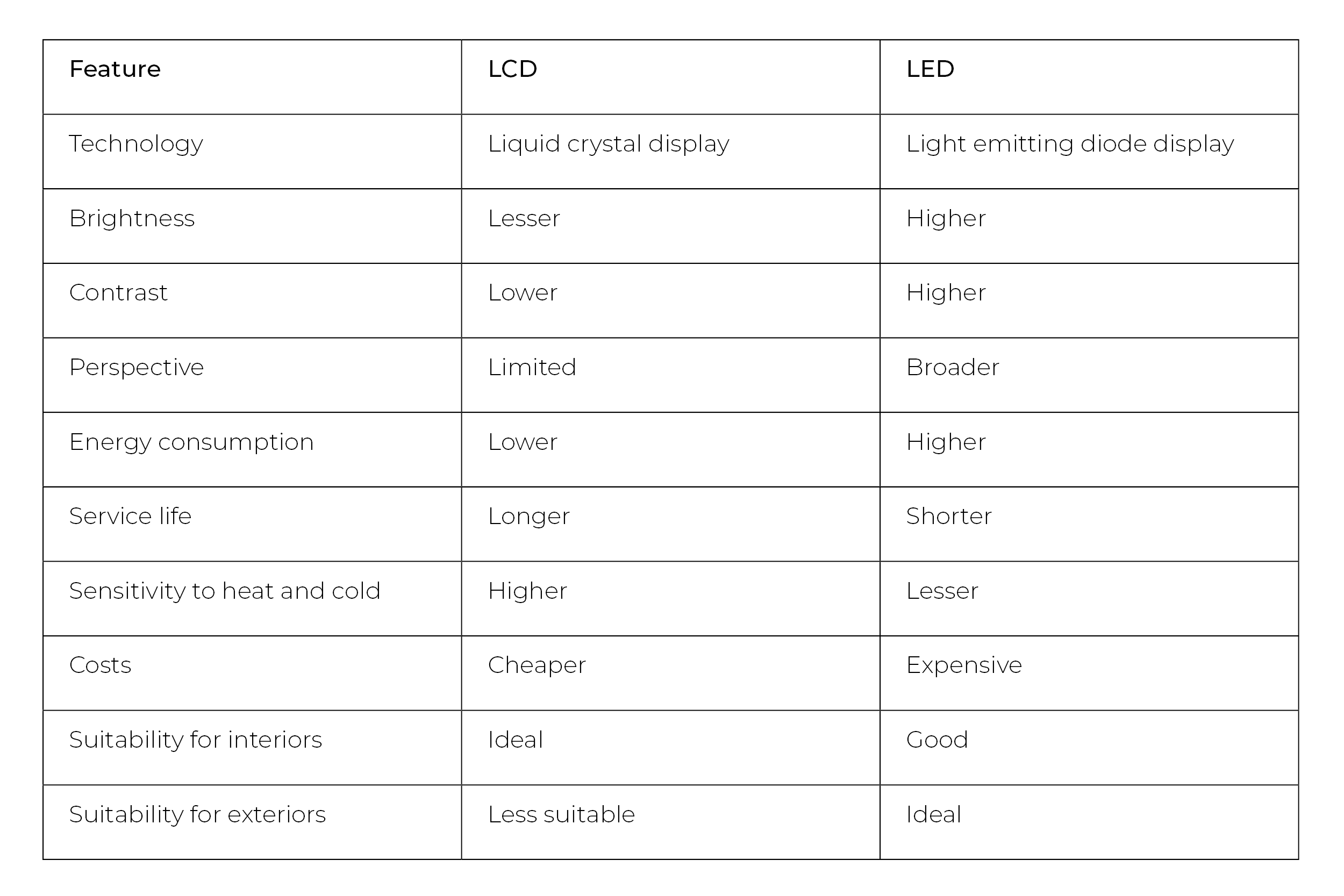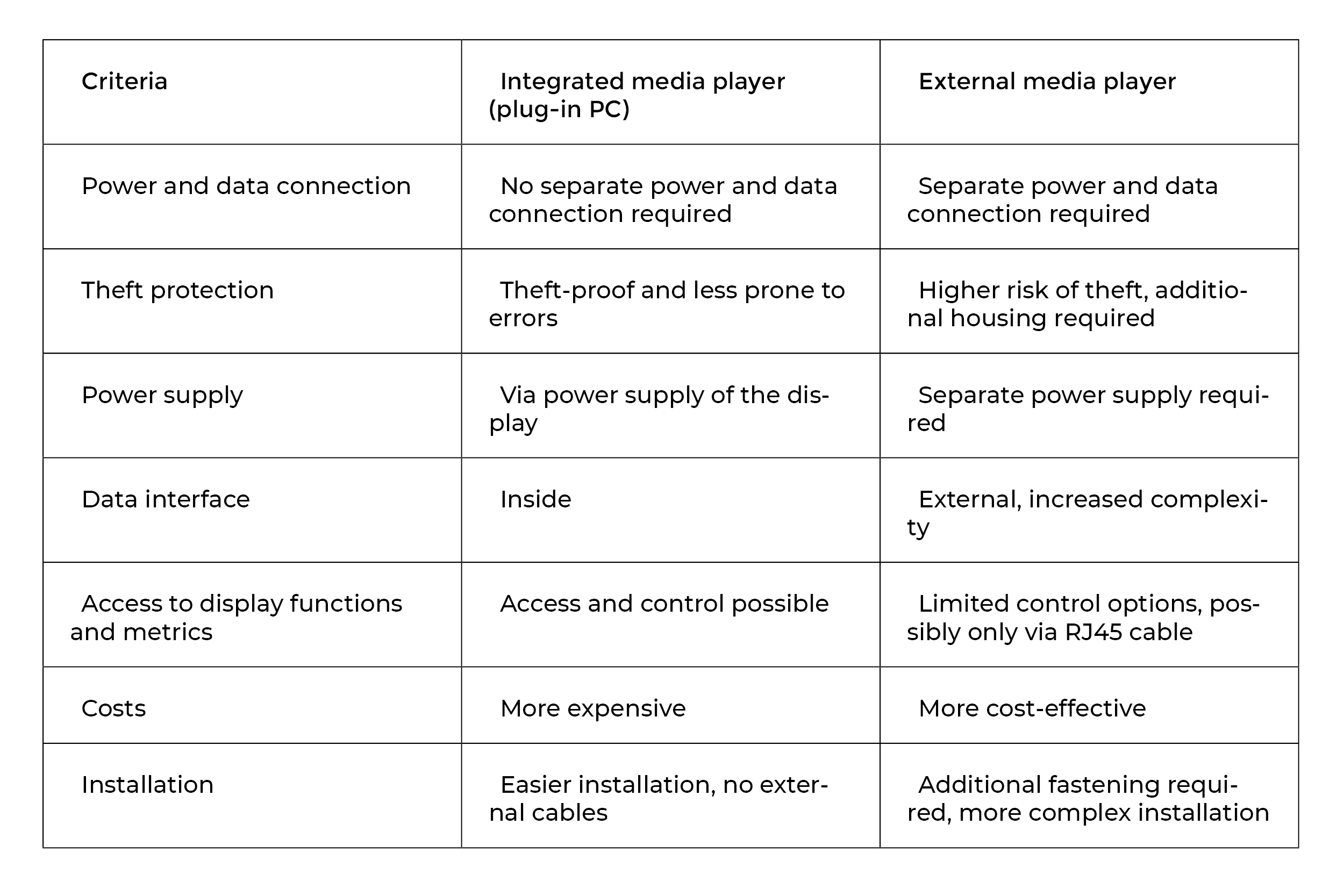
What do you need for digital signage?
Digital signage is a modern and effective method of presenting information and advertising in an appealing way. This technology is used in numerous industries to display content dynamically and targeted. But what exactly do you need to successfully implement a digital signage solution? This guide describes the key components and resources in detail.
1. Hardware components
a. Displays
The screen is the centrepiece of every digital signage solution. There are different display types such as LCD and LED, each of which offers different features and benefits:

When selecting the display, the intended use and location should be taken into account in order to achieve the best visibility and effect.
b. Media player
A media player is a central element of a digital signage solution as it plays the content and shows it on the display. There are two main types of media players: integrated (plug-in PC) and external media players. Both options have specific advantages and disadvantages.

The choice between an integrated and an external media player depends on the specific requirements and priorities. Integrated media players offer a more secure and less error-prone solution with comprehensive control options, but are more expensive. External media players are less expensive, but require additional installation and offer limited control options. Choosing the right media player depends on the specific requirements and the complexity of the content.
c. Mounting and housing
Secure and stable mounting of the screens is crucial. There are various options such as wall and ceiling mounts and stands. For outdoor installations, weatherproof and vandal-resistant housings are required to protect the screens.
At Bütema, we offer more than just standard solutions. Our customised floor and ceiling mounts are manufactured according to your specific wishes and requirements. This includes the option of supplying the enclosures in all RAL colours to ensure perfect integration into your design concept. Aesthetic aspects such as panelling for cables and computers are equally important to us so that your digital signage installations are not only functional but also visually appealing. As part of our comprehensive service, we take care of all the components of your digital signage project. You can rely on us to supply everything - from an 80-inch screen to the last screw on the ceiling mount. We also provide you with all the necessary peripherals, including flic buttons, RFID antennas and chips, ceiling sensors, all cables and payment terminals.

2. Software components
A content management system (CMS) is essential for managing and distributing content. Important functions of a CMS are:
Content creation: Simple creation and editing of content.
Scheduling: Plan when and where certain content is displayed.
Distribution: Automated distribution of content to the respective displays.
When selecting a CMS, user-friendliness, scalability and the possibility of integration with other systems should be taken into account.
3. Network requirements
A stable and fast internet connection is necessary to distribute and update content effectively. It is possible to use LAN (Local Area Network) or WLAN (Wireless Local Area Network), depending on the local conditions.
4. Content design and management
a. Types of content
Content is the be-all and end-all of a digital signage solution. The content breathes life into the solution and is often neglected when planning a project. Different types of content can be used on digital signage screens:
Videos: Movement attracts attention and can convey complex messages.
Images: Static images are easy to create and can create strong visual stimuli.
Text: Short, concise messages are effective and easy to update.
Interactive content: Enables direct interaction with users and offers a personalised experience. In Bütema AG's digital signage solution, the creation of your own interactive content is already integrated into the software - for more flexibility at low cost.
Product information: By connecting the digital signage solution to a retailer's merchandise management system, product content is displayed based on its availability.
External connections: News feeds, weather or social media content bring variety to content planning.
Media players: Media players are small, powerful devices that ensure the smooth playback of content on the displays. They ensure that the content provided is shown on the digital signage displays. The selection of a suitable media player depends on the specific requirements, including supported formats, network capability and performance. Some media players are also equipped with additional features such as remote management and diagnostics, making it easier to maintain and manage the system.
Network infrastructure: A reliable network infrastructure is essential to ensure the centralised control and updating of content. This includes both the physical network connection and the corresponding software solutions for managing the content. A stable and secure network enables the smooth distribution of content to all connected displays and ensures that updates can be rolled out in real time. Companies should ensure that their network infrastructure meets the requirements of the digital signage system to minimise downtime and ensure optimal performance. Standard LAN or WLAN networks are sufficient for this.

b. Timing and updating
Efficient content management is at the heart of any successful digital signage solution. Careful planning and regular content updates are crucial to attract and retain the attention of the target group. Timing and automated updates play a central role in this.
Time control: Planning when and for how long certain content should be displayed is an essential part of the digital signage strategy. Here are some important aspects that should be taken into account for time control:
Target group analysis: Determine when your target group is most likely to see the screens and which content is most effective at these times. For example, advertising content can be displayed during peak times, while informative content is presented at quieter times.
Time of day-dependent content: Adapt the content to the time of day. For example, news and weather reports can be displayed in the morning, while entertainment content or special offers are presented in the afternoon and evening.
Event-related content: Plan content based on special events or campaigns. For example, seasonal offers, holiday greetings or events can be advertised in a targeted manner. Good content management software allows you to plan ahead with start and end dates.
Duration of display: Decide how long certain content should remain visible. Content displayed for too long can become boring, while content displayed for too short a time may not attract enough attention.
Centralised content control: The use of tools to automatically update and distribute content is another key to efficient content management. Here are the benefits and methods of automated updates:
Centralised management: With a central content management system (CMS), content can be managed and controlled from one place. This facilitates coordination and ensures that all displays show the latest content.
Time-controlled updates: Automated tools make it possible to update content at set times. This is particularly useful for scheduling time-of-day or event-related content.
Real-time updates: If necessary, content can be updated in real time to respond to current events or changes. This is particularly important for industries such as retail or public transport, where up-to-date information is crucial.
Scalability: Automated updates make it possible to update content quickly and efficiently across a large number of displays. This is particularly beneficial for companies with multiple locations or large-scale installations

5. Installation and setup
a. Location analysis
The location of the screens is crucial to their impact and the success of your digital signage solution. Several factors play an important role here and must be carefully weighed up. Visibility is one of the most important aspects when analysing the location. The screens should be clearly visible and placed in areas with high footfall. This maximises the number of people who can see and respond to your content. Places such as entrance areas, waiting rooms, checkout areas or busy pedestrianised areas are particularly suitable to ensure maximum visibility and attention.
Another decisive factor is the viewing angle. It must be ensured that the screens are clearly visible from different viewing angles. This means that the type of screen chosen (LED or LCD) and the mounting height should be carefully considered to optimise visibility from different perspectives. A well-placed screen should be easily recognisable from a distance and from lateral viewing angles without compromising the image quality or legibility of the content.
b. Assembly and cabling
The correct installation of the hardware is crucial for the smooth operation and longevity of the digital signage solution. Both the mounting and the cabling play a central role in ensuring that the screens are stable, safe and fully functional.
Mounting: Secure mounting of the screens is essential to prevent them from falling or being damaged. Depending on the location and conditions, the screens can be mounted on walls or ceilings. The load-bearing capacity of the wall or ceiling must be checked and suitable brackets used. For heavier screens or special installation locations, such as in large halls or shopping centres, specially manufactured brackets may be required. Precision is important here: the screens must be precisely aligned to ensure optimum visibility and that they are stable and securely fastened.
Cabling: The laying of power and data cables is another important step in the installation of digital signage systems. A stable power supply is essential to keep the screens in operation 24/7. In addition, the data cables must be routed safely and properly to ensure a stable connection to the content and control systems. It is important to plan cable routes carefully to avoid tripping hazards and achieve an aesthetically pleasing installation. This includes the use of cable ducts or panelling to keep cables neat and protected.
6. Operation and updates
a. Regular updates
It is a great advantage for digital signage customers if software providers have integrated regular updates into their package and customers are therefore always up to date with the latest software. Regular updates ensure system security and keep the software up to date. This includes not only security patches, but also function updates that can improve performance and add new features. Automated update processes can help to carry out updates efficiently and ensure that all systems are always up to date.
b. Troubleshooting and problem solving
Reacting quickly to problems is crucial to minimise downtime and ensure the smooth operation of your digital signage systems. Remote hardware and software diagnostics enable simple and straightforward access to solutions to resolve problems quickly and easily. The conclusion of service contracts is a sensible measure to ensure fast and efficient support. With a service contract, you have access to professional technical support to help solve problems. These contracts can include regular maintenance, fast response times and spare parts supply. This ensures that technical problems are resolved quickly and that your digital signage systems are always operational. Overall, regular maintenance and quick troubleshooting are key to ensuring the longevity and efficiency of your digital signage solutions. Through proactive measures and professional support, you can ensure that your systems run reliably and trouble-free, which ultimately leads to greater satisfaction among your target group.

7. Conclusion
The successful implementation of digital signage requires careful planning and selection of the right components. From hardware and software to network requirements and legal aspects - every component plays an important role. With regular maintenance and optimisation, the maximum benefit can be gained from the digital signage solution. If you require further information or advice, please do not hesitate to contact us.
